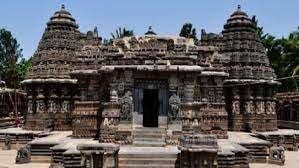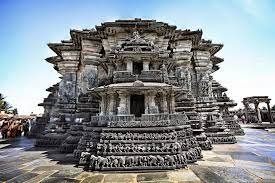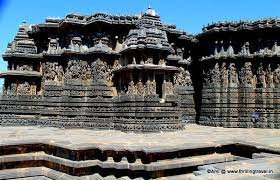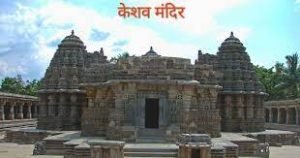03 Feb 2022 Hoysala Temple

- Recently the Union Ministry of Culture has designated the sacred monuments of Hoysala temples to be considered as ‘World Heritage Site’ for the year 2022-2023.
- The Hoysala temples built in the 12th-13th centuries are marked by three components of Belur, Halebidu and Somnathpur in Karnataka. These three Hoysala temples are protected monuments of the Archaeological Survey of India (ASI).
- The Sacred Monuments of the Hoysalas have been included in the potential list of UNESCO since April 15, 2014 and are a testimony to the rich historical and cultural heritage of India.
- Earlier UNESCO’s World Heritage Center (WHC) had agreed to publish Hindi description of ‘UNESCO World Heritage Sites’ of India on its website.
Features of Belur, Halebidu and Somanathapura Temples:
Chennakeshava Temple, Belur:

- This temple is dedicated to Lord Vishnu, who is known as ‘Chennakeshava’, which means ‘beautiful’ (Chenna) and ‘Vishnu’ (Keshava).
- Extensively carved stones on the exterior of the temple depict scenes from the life and reincarnation of Vishnu and the epics – Ramayana and Mahabharata.
- Although some temples associated with Shiva are also present here.
Hoysaleshwara Temple, Halebid:

- The Hoysaleshwara temple at Halebid is the most exemplary architecture of the present-day Hoysalas.
- It was built in 1121 AD during the reign of Hoysala king Vishnuvardhana Hoysaleshwar.
- This temple dedicated to Shiva was sponsored and built by the wealthy citizens and merchants of Dorasamudra.
- This temple is most famous for having more than 240 sculptures attached to the wall.
- Halebid has a walled complex which also houses three Jain temples of the Hoysala period.
Keshava Temple, Somanathapura:

- The Keshava Temple at Somanathapura is another splendid (perhaps the last) Hoysala monument.
- There is a beautiful Trikuta temple dedicated to Lord Krishna in these three forms of Janardhana, Keshava and Venugopal.
- Unfortunately the main Keshav idol is missing here and the idols of Janardana and Venugopal are damaged.
What are the characteristics of Hoysala architecture?
- Hoysala architecture is an architectural style developed under the Hoysala Empire between the 11th and 14th centuries, concentrated mostly in the southern Karnataka region.
- The Hoysala temples fall under the Hybrid or Besara style as their unique style is neither purely Dravidian nor Nagara.
- Hoysala temples have a basic Dravidian motif, but the Bhumija mode, widely used in central India, shows strong influences from the Nagara traditions of northern and western India, and the Carnatic Dravidian mode supported by the Kalyani Chalukyas.
- The Hoysala architects therefore considered the existing structures in other temple types and, after selecting and making due modifications, mixed these styles with their own special innovations.
- This culminated in the emergence of a completely innovative ‘Hoysala Temple’ style.
- Hoysala temples consist of several temples grouped around a central pillared hall rather than a simple inner hall with pillared halls, and the entire structure is an intricately designed star shape.
- Since these temples are built of steatite rocks, which is a relatively soft stone, the artists were able to give intricate forms to the sculptures. This can especially be seen in the ornaments of the deities that adorn the walls of the temple.
About World Heritage Site:
- Sites of special cultural or physical importance listed by UNESCO (United Nations Educational, Scientific and Cultural Organization) are known as World Heritage Sites.
- Sites are designated as having “Outstanding Universal Value” under the Convention on the Protection of the World Cultural and Natural Heritage 1972.
- The World Heritage Center serves as the secretariat for the operation of this Convention.
- It promotes the protection of natural and cultural sites of outstanding universal value throughout the world.
- It includes three types of sites: cultural, natural and mixed.
- Cultural heritage sites include historical buildings, city sites, important archaeological sites, monumental sculpture and painting works such as Dholavira a Harappan city.
- Natural heritage sites are limited to those natural areas that have excellent ecological and evolutionary processes, unique natural phenomena, habitats of rare or endangered species, etc. Example: Great Himalayan National Park Conservation Area.
- Mixed heritage sites contain elements of both natural and cultural importance. Example: Khangchendzonga National Park.
- Number of World Heritage Sites in India: There are a total of 40 World Heritage Sites in India, including 32 cultural, 7 natural and one mixed site. Dholavira, a Harappan city has been added recently.
- Nomination Process: As per UNESCO’s Operational Guidelines, 2019, it is mandatory for any monument/site to be placed on the tentative list for one year before being considered for the final nomination dossier.
- Once a nomination is made, it is sent to the World Heritage Center (WHC), which conducts a technical examination.
- Once submissions are made, UNESCO will contact again in early March. Thereafter site evaluation will take place in September/October 2022 and dossier will be considered in July/August 2023.


No Comments